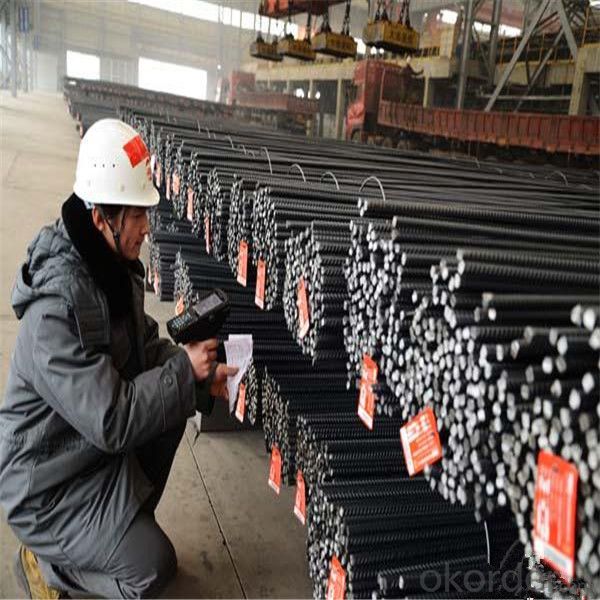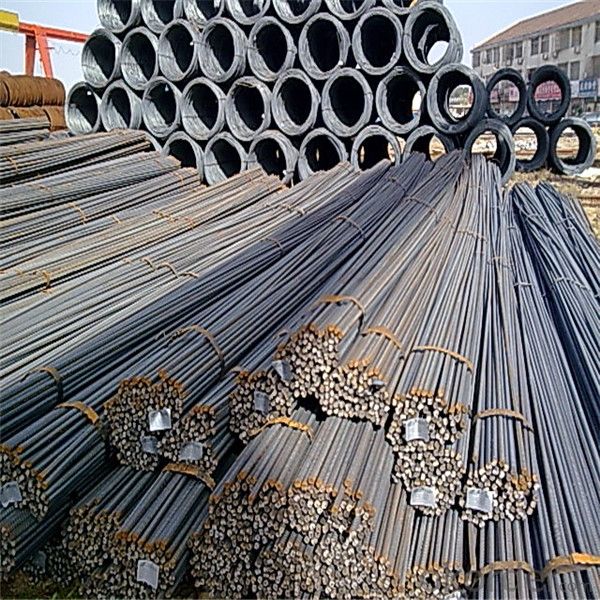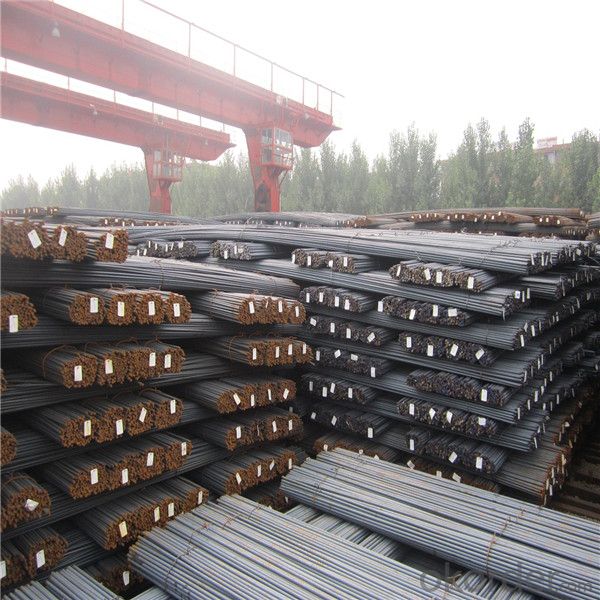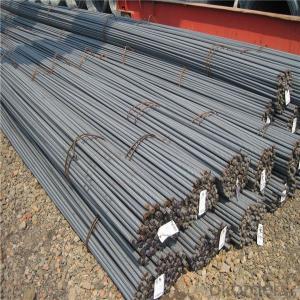Hot rolled Reinforcing Steel rebar 6-12m
- Loading Port:
- China main port
- Payment Terms:
- TT OR LC
- Min Order Qty:
- 1000 m.t.
- Supply Capability:
- 17497 m.t./month
OKorder Service Pledge
OKorder Financial Service
You Might Also Like
Item specifice
Rebar has ridges that bind it mechanically to the concrete with friction, it can still be pulled out of the concrete
under high stresses, an occurrence that often precedes a larger-scale collapse of the structure. To prevent such
a failure, rebar is either deeply embedded into adjacent structural members, or bent and hooked at the ends to lock
it around the concrete and other rebars. This first approach increases the friction locking the bar into place while the
second makes use of the high compressive strength of concrete.
Product Description :
Chemical composition (%): | Steel | C | Si | Mn | P | S | Ceq | ||||
HRB335 |
0.25 |
0.80 |
1.60 |
0.045 |
0.045 | 0.52 | |||||
HRB400 | 0.54 | ||||||||||
HRB500 | 0.55 | ||||||||||
Mechanical properties | Steel | Rel/ MPa | Rm/ MPa | A/ % | Agt/ % | ||||||
≥ | |||||||||||
HRB335 | 335 | 455 | 17 |
7.5 | |||||||
HRB400 | 400 | 540 | 16 | ||||||||
HRB500 | 500 | 630 | 15 | ||||||||
Package: | Standard export packing or as customer's request | ||||||||||
Application: | Construction, building, bridge, road. ect | ||||||||||
Payment terms | 1).100% irrevocable L/C at sight. | ||||||||||
Delivery time | 15-30 days after receipt of L/C or deposit by T/T | ||||||||||


Features
1、Pure steel quality, stable chemical contents, small tolerance.
2、Constant Quality, good drawing performance.
3、High dimension accuracy degree, accuracy degree of Level C up to 80%, smooth surface, less scale, easy to be pickled.
4、Automatic bundling with 4 lines by Machine in tidy and good looks
5、Big high quality percentage, small coil percentage, and heavy coil weight for Hard Coil.
6、High sorbitizing percentage.
Packing:
In bundles, each bundle weight 3.5 tons. Load by container or by bulk verssel.


FAQ:
1.Q: What's your MOQ(minimum order quantity)?
A: One full container, mixed acceptable .
2. Q: What's your packing methods?
A: Packed in bundle or bulk ..
3. Q: How can I buy CNBM products in my country?
A:Please send us an inquiry or email ,we will reply to you if there is distributor in your country
4. Q: Can we visit your factory?
A: Warmly welcome. Once we have your schedule, we will arrange the professional sales team to follow up your case.
5. Q: How long does it take to get the product if i place an order?
A:With the process of your requirements,we will pack and deliver in 3-7 days. If it is by sea shipment,it will take 15-45 days depending on different locations
- Q:Can steel rebars be used in the construction of hospitals and healthcare facilities?
- Yes, steel rebars can be used in the construction of hospitals and healthcare facilities. Steel rebars provide structural integrity and strength to the buildings, ensuring their safety and durability. Additionally, steel rebars are resistant to fire, moisture, and corrosion, making them suitable for healthcare facilities that require high standards of cleanliness and hygiene.
- Q:What is the role of steel rebars in minimizing the risk of concrete spalling due to sulfate attack?
- Steel rebars play a crucial role in minimizing the risk of concrete spalling due to sulfate attack by providing reinforcement and increasing the overall strength of the concrete structure. When concrete is exposed to sulfate ions, it can undergo a chemical reaction that leads to expansion and cracking, resulting in spalling. However, steel rebars act as a reinforcement, helping to distribute the stress and load throughout the concrete, reducing the risk of cracking and spalling. Additionally, the presence of rebars helps to maintain the structural integrity of the concrete, preventing the ingress of sulfate ions and minimizing the potential for sulfate attack.
- Q:What are the different types of couplers used for connecting steel rebars?
- There are various types of couplers used for connecting steel rebars, including mechanical couplers, lap splices, and welded couplers. Mechanical couplers are commonly used due to their ease of installation and ability to provide a strong connection. Lap splices involve overlapping the rebars and tying them together with wire or other fasteners. Welded couplers, on the other hand, require the rebars to be welded together to form a connection. Each type of coupler has its own advantages and disadvantages, and the choice depends on factors such as the project requirements, rebar size, and construction method.
- Q:What are the advantages of using deformed steel rebars?
- There are several advantages to using deformed steel rebars in construction projects. Firstly, the deformed shape of the rebars provides enhanced bonding with the surrounding concrete. The ridges, bumps, or indentations on the surface of the rebar increase the surface area in contact with the concrete, resulting in improved adhesion. This ensures a stronger bond between the rebar and the concrete, making the overall structure more resistant to forces such as tension, compression, and shear. Secondly, deformed steel rebars offer better resistance to slippage. The irregular surface of the rebar prevents it from easily slipping or moving within the concrete. This is particularly beneficial in structures subject to seismic activity or heavy loads, as it helps to maintain the integrity and stability of the construction. Additionally, the use of deformed steel rebars enhances the overall structural strength and durability of the project. The deformations on the surface of the rebar allow it to better absorb and distribute stress, making it less susceptible to cracking or failure under high loads. This strength and durability make deformed rebars suitable for a wide range of applications, including bridges, high-rise buildings, and industrial structures. Furthermore, deformed steel rebars provide cost-effectiveness in long-term maintenance. The improved bond between the rebar and concrete reduces the risk of corrosion and deterioration over time. This leads to reduced maintenance and repair costs, as the structure remains more resilient and less prone to structural degradation caused by environmental factors. Lastly, deformed steel rebars offer versatility in design. The various types and sizes of deformed rebars available in the market allow engineers and designers to choose the most appropriate option for their specific project requirements. The flexibility in design ensures that the rebars can be tailored to meet the structural demands of different applications, thus contributing to the overall efficiency and safety of the construction project. In conclusion, the advantages of using deformed steel rebars include enhanced bonding with concrete, resistance to slippage, improved structural strength and durability, cost-effectiveness in maintenance, and versatility in design. These advantages make deformed steel rebars a preferred choice in construction projects where strength, stability, and long-term performance are crucial factors.
- Q:What is the impact strength of steel rebars?
- The impact strength of steel rebars is high, making them capable of withstanding heavy loads and absorbing energy without breaking or fracturing easily.
- Q:What is the effect of steel rebars on the weight of a structure?
- Steel rebars have a significant effect on the weight of a structure. Rebars are typically made of steel, which is known for its high strength-to-weight ratio. When incorporated into a structure, these reinforcement bars add strength and rigidity without significantly increasing the overall weight. By reinforcing concrete with steel rebars, the structure becomes better equipped to withstand various forces and stresses, such as tension, compression, bending, and shearing. This reinforcement allows the structure to handle heavier loads and increases its overall durability and longevity. While steel rebars add strength to the structure, they do not significantly contribute to its weight. This is beneficial as it allows for the construction of lighter and more efficient structures. The reduced weight can have several advantages, including lower construction costs, reduced material requirements, decreased transportation costs, and improved seismic performance. Moreover, the use of steel rebars also enables the construction of more slender and aesthetically pleasing structures. The increased strength provided by the rebars allows for the use of thinner concrete sections, resulting in sleek designs and more open spaces. In summary, the effect of steel rebars on the weight of a structure is minimal. Instead, their primary role is to enhance the structural integrity, strength, and durability of the building without adding excessive weight.
- Q:What is the difference between three - grade steel and other grades?
- 1, different grades of steel (chemical composition is different). HRB335 grade steel is 20MnSi (20 manganese silicon); HRB400 grade steel bars are 20MnSiV or 20MnSiNb or 20MnTi etc.;2, strength is different, HRB335 grade steel tensile and compressive design strength is 300MPa, HRB400 grade steel tensile and compressive design strength is 360MPa.
- Q:What is the process of bending steel rebars into shapes other than straight bars?
- To create shapes other than straight bars, steel rebars undergo a series of steps and techniques. Initially, measurement and marking are carried out to identify the desired bending points and angles. A measuring tape, square, and marker are typically utilized for this purpose. Following this, the rebars are fastened within a bending machine or a manual bending tool. The bending machine comprises a bending head and a bending table as its primary components. The rebars are positioned on the bending table, while the bending head is adjusted to the desired angle and position. Once the rebars are securely placed, the bending process commences. Manual tools like a rebar bender or cutter can be utilized for smaller rebars. These tools enable the worker to exert force and bend the steel rebar into the desired shape. For larger rebars or intricate shapes, a hydraulic bending machine is often employed. This machine employs hydraulic pressure to bend the rebars, allowing for enhanced precision and control. The operator can modify the bend's angle and radius to achieve the desired shape. Throughout the bending process, it is crucial to prevent overstressing or damaging the rebars. Excessive bending can weaken the rebars and jeopardize their structural integrity. Hence, it is essential to adhere to the bending specifications and guidelines provided by engineers and construction standards. Once the rebars have been bent into the desired shape, they are typically inspected for any defects or imperfections. This inspection ensures that the rebars conform to the required standards and can be safely utilized in construction projects. In conclusion, the process of bending steel rebars into shapes other than straight bars involves measurement and marking, securing the rebars in a bending machine, applying force or hydraulic pressure to bend the rebars, and inspecting the final product for quality assurance. This process necessitates precision, skill, and adherence to safety guidelines to ensure the rebars can withstand the intended structural loads.
- Q:What is the process of installing steel rebars in slabs and beams?
- The process of installing steel rebars in slabs and beams involves several steps to ensure proper reinforcement of the concrete structure. 1. Design and engineering: Before starting the installation process, the structural engineer designs the reinforcement layout based on the specific requirements of the project. This design considers factors such as load-bearing capacity, span length, and structural integrity. 2. Marking and layout: Once the design is finalized, the layout is marked on the slab or beam using chalk lines or other appropriate methods. This helps guide the installation process and maintain accuracy. 3. Cutting and bending rebars: Steel rebars are usually delivered in long lengths and need to be cut and bent according to the specific dimensions and angles required by the design. This process is done using specialized tools like rebar cutters and benders. 4. Placement and support: After the rebars are cut and bent, they are placed in the marked positions on the slab or beam. The rebars are supported using rebar chairs, spacers, or other suitable devices to ensure they remain in the correct position during the pouring of concrete. 5. Tying and securing: Once the rebars are correctly positioned, they are tied together using wire or other appropriate binding material. This ensures the rebars remain in their designated spots and maintain proper spacing and alignment. 6. Inspection and approval: After the rebars are installed, an inspection is carried out to verify that they meet the design specifications and are properly positioned. This inspection is usually performed by a qualified engineer or inspector who checks for compliance with building codes and standards. 7. Concrete pouring: After the rebars are inspected and approved, the concrete is poured over the reinforced area. The rebars act as reinforcement, providing added strength and stability to the structure. 8. Curing and finishing: Once the concrete is poured, it needs to cure and harden over a specific period. During this time, it is essential to protect the newly installed rebars and concrete from excessive moisture and temperature fluctuations. After curing, finishing processes such as leveling, smoothing, and surface treatments may be carried out to achieve the desired appearance and functionality. Overall, the process of installing steel rebars in slabs and beams involves careful planning, precise cutting and bending, accurate placement, proper securing, and thorough inspection to ensure a reinforced structure that meets design requirements and provides long-lasting strength and durability.
- Q:What is the process of reinforcing concrete columns with steel rebars?
- The process of reinforcing concrete columns with steel rebars involves several steps to ensure structural integrity and strength. Firstly, the design and specifications of the concrete column are determined based on the required load-bearing capacity and other structural considerations. This includes determining the size, shape, and location of the rebars within the column. Next, the concrete formwork is prepared, which involves constructing a temporary mold or framework in the desired shape and dimensions of the column. This formwork provides support and containment for the concrete during pouring and curing. Once the formwork is in place, the steel rebars are carefully positioned and secured within the formwork. The rebars are typically arranged in a specific pattern to provide maximum reinforcement and strength. This pattern may include vertical bars along the length of the column, as well as horizontal bars that wrap around the vertical bars. The rebars are usually tied together at intersections using wire or other fasteners to maintain their position and prevent movement during the concrete pouring process. This ensures that the rebars are properly embedded within the concrete and will effectively reinforce the column. After the rebars are securely in place, the concrete is poured into the formwork. The concrete mixture is carefully placed and consolidated to ensure it completely surrounds and encases the rebars. This helps to bond the concrete and steel together, creating a composite material that is stronger and more resistant to cracking and deformation. Once the concrete is poured, it is left to cure and harden. This typically involves a period of several days or weeks, during which the concrete gains strength and durability. Proper curing is crucial to ensure the rebars and concrete bond together effectively and the column achieves its intended load-bearing capacity. After the concrete has fully cured, the formwork is removed, revealing the reinforced concrete column. The rebars should be fully embedded within the concrete, providing additional strength and support to withstand the applied loads. Overall, the process of reinforcing concrete columns with steel rebars requires careful planning, positioning, and securing of the rebars within the formwork, followed by the pouring, curing, and removal of the formwork. This process ensures the resulting reinforced concrete column is structurally sound and capable of withstanding the intended loads and forces.
1. Manufacturer Overview |
|
|---|---|
| Location | |
| Year Established | |
| Annual Output Value | |
| Main Markets | |
| Company Certifications | |
2. Manufacturer Certificates |
|
|---|---|
| a) Certification Name | |
| Range | |
| Reference | |
| Validity Period | |
3. Manufacturer Capability |
|
|---|---|
| a)Trade Capacity | |
| Nearest Port | |
| Export Percentage | |
| No.of Employees in Trade Department | |
| Language Spoken: | |
| b)Factory Information | |
| Factory Size: | |
| No. of Production Lines | |
| Contract Manufacturing | |
| Product Price Range | |
Send your message to us
Hot rolled Reinforcing Steel rebar 6-12m
- Loading Port:
- China main port
- Payment Terms:
- TT OR LC
- Min Order Qty:
- 1000 m.t.
- Supply Capability:
- 17497 m.t./month
OKorder Service Pledge
OKorder Financial Service
Similar products
New products
Hot products
Related keywords



























